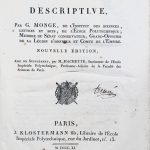GHETALDI 1603
- Description
Description
Marini Ghetaldi Patricii Ragusini promotus Archimedis, seu, De variis corporum generibus gravitate & magnitudine comparatis, Romae, apud Aloysium Zannetum, 1603 – reprint by the Institut da provijest Prirodnih, Zagreb 1963
Marino Ghetaldi (1568 –1626) was a Ragusan scientist. A mathematician and physicist who studied in Italy, England and Belgium, his best results are mainly in physics, especially optics, and mathematics. He was one of the few students of François Viète and friend of Giovanni Camillo Glorioso.
Born into the Ghetaldi noble family, he was one of six children. He was known for the application of algebra in geometry and his research in the field of geometrical optics on which he wrote 7 works including the Promotus Archimedis (1603) and the De resolutione et compositione mathematica (1630). He also produced a leaflet with the solutions of 42 geometrical problems, Variorum problematum collectio, in 1607 and set grounds of algebraization of geometry. His contributions to geometry had been cited by Dutch physicist Christiaan Huygens and Edmond Halley, who calculated the orbit of what is known as Halley’s comet, in England.
The Promotus Archimedis is Ghetaldi’s first publication in which he attempted to recreate Apollonius΄s lost works. He was taught by Christophorus Clavius and François Viète, the work of the latter on Apollonius resulting in the nickname of Apollonius Gallus.
Ghetaldi was the constructor of the parabolic mirror (66 cm in diameter), kept today at the National Maritime Museum in London. He was also a pioneer in making conic lenses. During his sojourn in Padua he met Galileo Galilei, with whom he corresponded regularly. He was a good friend to the French mathematician François Viète. He was offered the post of professor of mathematics in Old University of Leuven in Belgium, at the time one of the most prestigious university centers in Europe.
Please contact us for more information here










